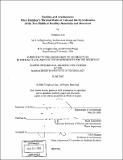Tactility and architecture : Peter Zumthor's Thermal baths in Vals and the hybridization of the two motifs of tactility-materiality and movement
Author(s)
Lee, Tonghoon, 1972-
DownloadFull printable version (12.96Mb)
Alternative title
Peter Zumthor's Thermal baths in Vals and the hybridization of the two motifs of tactility-materiality and movement
Other Contributors
Massachusetts Institute of Technology. Dept. of Architecture.
Advisor
Mark Jarzombek.
Terms of use
Metadata
Show full item recordAbstract
Tactility holds a unique position in modem architectural discourse. Oftentimes, it has been evoked "as an alternative to two-dimensional vision. However, the notion of tactility sometimes denotes ambiguous and often conflicting meanings. Since the 1970s, tactility has been mainly associated with a series of phenomenological notions such as place, rooted-ness, corporeality, intimacy, sensuousness, and craftsmanship. The noted Swiss architect, Peter Zumthor (b.1943), follows in this vein by conceptualizing tactility in terms of intimate contact between the occupant's bodily organs and the surfaces of architecture. The characteristics of Zumthor's architecture cannot, however, be exhausted by these considerations. I argue that his buildings are just as exceptional in terms of their spatial conception as they are in their material realization. In this sense, Zumthor's emphasis on "tactility" in his architecture does not do justice to his own buildings. To fully appreciate them, this thesis attempts to go beyond a mere equivalency between tactility and appreciation of surface to develop a richer and more complex notion of tactility. I will argue that more seminal, spatial conceptions of tactility can be found in modem aesthetic discourse, particularly, in the two motifs of "tactility as materiality" and "tactility as movement," as articulated in the works of Alois Riegl and Walter Benjamin, respectively. I will attempt to show that these motifs have their correlative expressions in the spatial languages of Adolf Loos's "Raumplan" and Le Corbusier's "Plan Libre." Finally, I will show how Zumthor's architecture, particularly his Thermal Baths in Vals (1986-96), Switzerland, successfully hybridizes these two spatial languages and thus the two motifs of tactility as well.
Description
Thesis (S.M.)--Massachusetts Institute of Technology, Dept. of Architecture, 2002. Includes bibliographical references (leaves 68-72).
Date issued
2002Department
Massachusetts Institute of Technology. Department of ArchitecturePublisher
Massachusetts Institute of Technology
Keywords
Architecture.